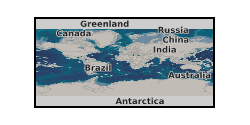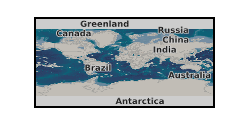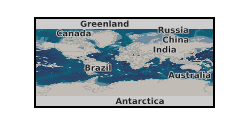Heterogeneity
Type of resources
Available actions
Topics
Keywords
Contact for the resource
Provided by
Years
Formats
Update frequencies
-

The data are from a suite of friction experiments performed on simulated fault gouges comprised of clay-quartz mixtures, sheared in a direct-shear arrangement. Some experiments were performed on gouge layers comprised of adjacent patches of kaolinite-clay and quartz (i.e. heterogeneous gouge layers), whereas others were performed on homogeneous mixtures of the two materials (i.e. homogeneous gouge layers). More information on the different types of experiment is provided in the accompanying metadata for this dataset. The relative proportions of clay and quartz were varied in different experiments. All experiments were performed at an effective normal stress of 40 MPa. The sliding velocity was stepped between 0.3 and 3 microns/s every 1 mm of displacement to calculated the rate-and-state friction parameter (a-b). The evolution of shear stress was monitored with increasing displacement (up to a maximum displacement of 8.5 mm).
-

The data presented herein comprises raw and upscaled medical X-Ray CT data, MATLAB processing files and MATLAB analytical model files for the paper ‘Rate dependency of capillary heterogeneity trapping for CO2 storage’. The medical X-ray CT data is organised as three repeat experiments, each at a different flow rate. Full core scans capture the steady state core flood experiments. The core is a heterogenous Bentheimer outcrop (39 mm diameter, 15 cm length). Experimental MATLAB processing files upscale the saturation values in 3D. Post-processing MATLAB files are used to produce figures in the paper. The MATLAB analytical model files contain input parameters and code needed to run the analytical model and compare with experimental results.
-

We collected major element, trace element and Nd isotopes of cumulate plagioclase and clinopyroxene in lower crustal gabbros from Hess Deep oceanic crust (~2°15'N, 101°30'W) to investigate the Nd isotopic heterogeneity of melts delivered to a complete section of Hess Deep oceanic crust, accreted at the fast-spreading (133 mm/yr) East Pacific Rise (EPR). These data are presented in Cooper et al. (2025) (https://doi.org/10.1130/G52872.1). Elemental maps of 58 samples were initially obtained prior to selecting a subset of 25 samples for in-situ microanalysis. We targeted the Nd isotope record of cumulate plagioclase and clinopyroxene from lower crustal gabbro samples, representing early crystallisation products of melts delivered to the crust. These samples were collected in several expeditions: Ocean Drilling Program (ODP) Leg 147; RSS James Cook cruise JC21; Integrated Ocean Drilling Program (IODP) Expedition 345 (Site U). Combined, these studies provide the most complete composite section of fast-spreading EPR crust to date (stratigraphic depth of 4350 m to 25 m). In our study, we selected 25 samples for in situ Nd isotope microanalysis, covering the range of mineralogy and textural diversity, and over the full stratigraphic depth. For a comparison to local MORB compositions, we selected a set of 13 upper-crustal sheeted dikes collected on the RSS James Cook cruise JC21. Our data reveal that the mantle is heterogeneous at the scale of melt extraction, and the crystal record from the lower crust shows greater 143Nd/144Nd heterogeneity than the overlying MORB. Hence, Pacific MORBs do not reflect the full heterogeneity of their mantle source, and some aggregation of melts occurs within the crust. Data was collected between 2020 and 2023 by George Cooper, Johan Lissenberg and Max Jansen at Cardiff University, UK, as part of NERC Grant NE/T000317/1:HiDe: A Highly Heterogeneous Depleted Upper Mantle? Mineral isotopic analyses were performed on a Thermo Scientific TRITON Plus at the Vrije Universiteit in Amsterdam. The long-term average and reproducibility (2019–2022) for the JNdi-1 standard is 0.512094 ± 0.000011 2 SD (standard deviation; n = 28) with 1011Ω resistors (used for clinopyroxene) and 0.512105 ± 0.000044 2 SD (n = 45) with four 1013Ω resistors (used for plagioclase). Full methodology can be found within the supplemental Material of Cooper et al. (2025) at https://doi.org/10.1130/GEOL.S.28485770 The DOI is a supplement to https://doi.org/10.1130/G52872.1 Methodology: https://gsapubs.figshare.com/articles/journal_contribution/Supplemental_Material_Crustal_versus_mantle-level_aggregation_of_heterogeneous_melts_at_mid-ocean_ridges/28485770?file=52665137
-

This collection comprises two time-series of 3D in-situ synchrotron x-ray microtomography (μCT) volumes showing two Ailsa Craig micro-granite samples (ACfresh02 and ACHT01) undergoing triaxial deformation. These data were collected in-situ at the PSICHE beamline at the SOLEIL synchrotron, Gif-sur-Yvette, France in December 2016 (standard proposal 20160434) and are fully explained in Cartwright-Taylor A., Main, I.G., Butler, I.B., Fusseis, F., Flynn M. and King, A. (in press), Catastrophic failure: how and when? Insights from 4D in-situ x-ray micro-tomography, J. Geophys. Res. Solid Earth. Together, these two time-series show the influence of heterogeneity on the micro-crack network evolution. Ailsa Craig micro-granite is known for being virtually crack-free. One sample (ACfresh02) remained as-received from the quarry until it was deformed, while the second (ACHT01) was slowly heated to 600 degC and then slowly cooled prior to deformation in order to introduce material disorder in the form of a network of nano-scale thermal cracks. Thus these two samples represent two extreme end-members: (i) ACfresh02 with the lowest possible (to our knowledge) natural pre-existing crack density, and so is a relatively homogeneous sample and (ii) ACHT01 with a thermally-induced nano-crack network imprinted over the nominally crack-free microstructure, and therefore has increased heterogeneity relative to ACfresh02. Each 3D μCT volume shows the sub-region of each sample in which the majority of damage was located and has three parts. Part one is reconstructed 16-bit greyscale data. Part two is 8-bit binary data showing individual voids (pores and micro-cracks) in the dataset after segmentation. Part three is 32-bit data showing the local thickness of each void, as in Cartwright-Taylor et al. (in press) Figures 4 and 5. Each part is a zip file containing a sequence of 2D image files (.tif), sequentially numbered according to the depth (in pixels, parallel to the loading axis) at which it lies within the sample volume. File dimensions are in pixels (2D), with an edge length of 2.7 microns. Each zip file is labelled with the sample name, the relevant letter for each 3D volume as given in Cartwright-Taylor et al. (in press) Tables 3 and 4, part 1, 2 or 3 (depending whether the data are greyscale, binary or local thickness respectively), the differential stress (MPa) on the sample, and the associated ram pressure (bar) to link with individual file names. The following convention is used: sample_letter_part_differentialstress_rampressure_datatype. Also included are (i) two spreadsheets (.xlsx), one for each sample, containing processing parameters and the mechanical stress and strain at which each volume was scanned, and (ii) zip files containing .csv files containing measurement data for the labelled voids in each volume. N.B. void label numbers are not consistent between volumes so they can only be used to obtain global statistics, not to track individual voids.
-

This work presents a detailed three-dimensional finite element based model for wave propagation, combined with a postprocessing procedure to determine the fracture intensity caused by blasting. The data generated during this project includes output files of all simulations with detailed fields, geometries and meshes. The model incorporates the Johnson-Holmquist-2 constitutive model, which is designed for brittle materials undergoing high strain rates and high pressures and fracturing, and a tensile failure model. Material heterogeneity is introduced into the model through variation of the material properties at the element level, ensuring jumps in strain. The algorithm for the combined Johnson-Holmquist-2 and tensile failure model is presented and is demonstrated to be energy-conserving, with an open-source MATLABTM implementation of the model. A range of sub-scale numerical experiments are performed to validate the modelling and postprocessing procedures, and a range of materials, explosive waves and geometries are considered to demonstrate the model's predictive capability quantitatively and qualitatively for fracture intensity. Fracture intensities on 2D planes and 3D volumes are presented. The mesh dependence of the method is explored, demonstrating that mesh density changes maintain similar results and improve with increasing mesh quality. Damage patterns in simulations are self-organising, forming thin, planar, fracture-like structures that closely match the observed fractures in the experiments. The presented model is an advancement in realism for continuum modelling of blasts as it enables fully three-dimensional wave interaction, handles damage due to both compression and tension, and relies only on measurable material properties. The uploaded data are the specific simulation outputs for four explosion models occurring on two different rock types, and the specific fracture patterns generated.
 NERC Data Catalogue Service
NERC Data Catalogue Service